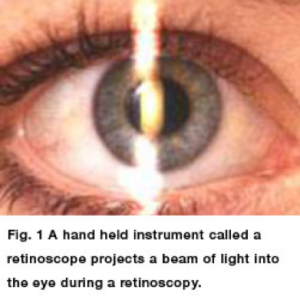What is retinoscopy?
Retinoscopy (also called skiascopy) is a technique to objectively determine the refractive error of the eye (farsighted, nearsighted, astigmatism) and the need for glasses. The test can be quick, easy, reliably accurate and requires minimal cooperation from the patient.
How is it performed?

A hand held instrument called a retinoscope projects a beam of light into the eye [See figure 1]. When the light is moved vertically and horizontally across the eye, the examiner observes the movement of the reflected light from the back of the eye. This reflection is called red reflex. The examiner then introduces lenses in front of the eye and as the power of the lenses changes, there is a corresponding change in the direction and pattern of the reflection. The examiner keeps changing the lenses until reaching a lens power that indicates the refractive error of the patient.
When is retinoscopy used?
Retinoscopy is used to determine refractive error in children, developmentally delayed adults, or in individuals whose behavior limits the ability to be cooperative with autorefraction or subjective refraction. It is especially useful in very young children and infants.
Are dilating eye drops necessary for retinoscopy?
Children’s eyes are typically dilated for retinoscopy. This is because the reflex is easier to see when the pupil is large and because the drops temporarily limit the eye’s ability to accommodate or focus. This allows for a more accurate determination of the refractive error.
Will general anesthesia be necessary for retinoscopy?
For accurate retinoscopy the child should look at the examiner’s light for a time period that varies from few seconds to few minutes. Most children, including infants, can look at the light long enough to allow successful retinoscopy in the office without anesthesia. However, in some cases general anesthesia may be needed if the child does not look at the light for the time period required for retinoscopy.
What other techniques can be used to determine the refractive error of a child?
Autorefraction and subjective refraction are other techniques used to determine refractive error. Autorefraction is a method of retinoscopy that is performed by a computing device. This method can be precise, but requires the subject to be still and look at a target for several seconds in order to obtain an accurate measurement. Subjective refraction is a method that can be used to refine the results of retinoscopy or autorefraction. Subjective refraction requires participation in the process by telling the examiner which of a series of choices of lenses provides the clearest vision.
Credits: Journal of American Association for Pediatric Ophthalmology and Strabismus